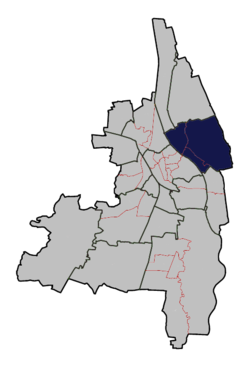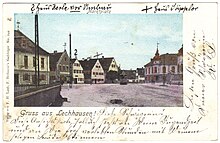Augsburg-Lechhausen
|
Lechhausen planning room (VI) of Augsburg |
|
|---|---|
| Coordinates | 48 ° 22 '52 " N , 10 ° 54' 58" E |
| height | 465- 480 m above sea level. NN |
| surface | 10,475.7 km² |
| Residents | 33,865 (Dec. 31, 2013) |
| Population density | 3233 inhabitants / km² |
| Postcodes | 86165, 86167, 86169 |
| structure | |
| Townships |
|
| Source: area population | |
After the city center, Lechhausen is the most populous district of Augsburg with a population of around 33,900 on an area of around 10.5 km². It includes the city districts 25 (Lechhausen-Süd), 26 (Lechhausen-Ost) and 27 (Lechhausen-West) and thus represents planning area VI.
history
middle Ages
Around 800 a bridge was built over the Lech near Lechhausen, which was owned by Bishop Simpert of Augsburg, in order to be able to graze on the grassy areas there. The erection of huts for the shepherds was arranged. Lechhausen was first mentioned in a document in 1130, when Amalbertus, “nobilis homo de Lechhusen” handed over part of his property to the Wessobrunn monastery . The village, which at that time had fewer than 20 houses, changed hands several times. The plague , severe winters and dry summers led to increasing impoverishment in Lechhausen. On March 12, 1362, the knight Hans von Schwenningen had the whole of Lechhausen burned down in order to avenge his brother who had been executed in Augsburg. Ten years later, the now completely impoverished village was sold to the Augsburg colonel Nördlinger for 875 guilders. A first sketch of the village has survived from this period, showing 18 houses and a church. The cathedral monastery Augsburg took over the possession of Lechhausen in 1395. In the following years there were disputes between the imperial city of Augsburg and the Bavarian dukes over the possession of Lechhausen, in which Lechhausen went up in flames in 1462. As a result, the village was on the instructions of Friedrich III. subordinated to the district court Friedberg .
Modern times
In 1603 the Duchy of Bavaria took over sovereignty over Lechhausen. Once again the settlement was completely destroyed in the Thirty Years War . As compensation for the damage suffered in the War of the Spanish Succession , Lechhausen was incorporated into Augsburg for fourteen years in 1705. When the Bavarian Elector Max Emanuel took possession of his land again, he in turn demanded reparation from Augsburg. Around 1760 in Lechhausen, against the resistance of Augsburg, a raft landing was set up at the Lech Bridge . In 1850 the village had 474 houses and 3250 inhabitants. This made Lechhausen the largest Bavarian village. In 1862 the Lechhaus volunteer fire brigade was founded. In October 1881 the first horse-drawn tram to Augsburg went into operation.
City elevation and incorporation
On January 1, 1900, Lechhausen received its town charter with 14,172 inhabitants. The city flag was red and blue, and a coat of arms announced the new dignity. The Städtische Sparkasse Lechhausen was founded six months later . A devastating flood hit the city on June 16, 1910. The damage suffered and investments in the water supply, sewerage, hospital and road construction that had become urgent, gave rise to the idea of a connection to Augsburg. On January 1, 1913, the city of Lechhausen with an area of 2800 hectares and around 18,500 inhabitants was separated from the Upper Bavarian district office of Friedberg and incorporated into the Swabian government capital Augsburg, which more than doubled its area.
Destruction in World War II
On the night of February 26, 1944, the city of Augsburg was attacked by British bomber units . The Lechhausen district was hit hardest. The first bombs fell at 10:40 p.m. and a second attack took place at 1 a.m. 730 dead and 1,335 injured were the victims of this attack, 90,000 were homeless. A total of 2,700 buildings with 12,400 apartments and 380 industrial buildings were destroyed.
Population development
From 1855 until the incorporation in 1913, from 2004
|
|
|
education
School history
There is said to have been a teacher in Lechhausen as early as 1557. In 1620 the first Lechhauser school house with only one classroom was built, in which up to 136 school children were taught. The Pankratius School followed in 1806. A year later, the old schoolhouse was sold and in 1931 demolished. In the school year 1872/73 Georg Kerschensteiner was appointed second assistant teacher. The first commercial vocational school was established in 1874. The Protestant school followed in 1875, and the Max School in 1877. In 1892 the monastery school was inaugurated. The girls' school house of the Pankratius School was converted into the town hall in the same year, and the police station has been located in the building since the incorporation. The Luitpold primary school was given its intended purpose in 1901, and the Schiller primary school followed just 7 years later (later the Ostkrankenhaus , now a senior citizens' home ). With the exception of the Luitpold School, all Lechhauser schools were destroyed during the Second World War. The reconstruction of the existing facilities took place in the following years. With the settlement of the Lechhausen-West area in 1952, the Birkenau and Goethe elementary schools were established. In 1958, the Augsburg University of Education of the University of Munich was established in Schillstrasse ( incorporated into the University of Augsburg since 1972 ).
Educational institutions
In the Lechhausen district there are three elementary schools , two secondary schools and a special educational support center . The Bayernkolleg , an institution of the second educational path in the field of Bavarian grammar schools, leads from professional activity or vocational training to general higher education entrance qualification .
General education schools
- Birkenau primary school
- Goethe Middle School
- Luitpold Primary School
- Schiller elementary and middle school
- Pankratius School (Special Education Center III)
further education
- Bayernkolleg (institute for university entrance qualification)
Libraries
- District library of the New City Library Augsburg
- Reading island at the Birkenau elementary school
- Catholic Parish Library St. Elisabeth
societies
- 1. Poker club Augsburg Lechhausen 2010 e. V.
- AGL Action Group Lechhausen
- Aikido Association Augsburg e. V. in Augsburg (Lechhausen)
- Working group of Lechhauser associations and organizations (ARGE)
- Augsburg-Lechhausen Wind Orchestra
- Cosmos Lechhausen e. V.
- DJK Augsburg-Lechhausen 1920 e. V.
- Frohsinn Choir Augsburg-Lechhausen e. V. (since 1897)
- Horticultural Association Augsburg-Lechhausen e. V.
- Lechhausen 2013 e. V.
- Friends of nature in Germany OG Lechhausen e. V.
- RSG Radsportgemeinschaft Augsburg e. V. on the Augsburg cycling track
- Schachclub Lechhausen 1908 e. V.
- SC Lechhausen 05
- Savings association "Unity" Lechhausen
- Lechhausen traditional costume association (since 1905)
- TSG 1885 Augsburg e. V.
- The divers e. V. (Your diving club in Augsburg since 1986)
- Veloclub Lechhausen e. V.
traffic
Traffic history
The first bridge over the Lech was built as early as 801 AD under Bishop Simpert of Augsburg. Since the Lech is the historical border between Upper Bavaria and Swabia, bridge tolls were raised. Until the bridge was built, the small settlement could only be reached via several fords or you had to have the "Förgen" ( ferryman ) put you across the river. In 1807 the first Lechhauser bridge was built , where the Ulrichsbrücke stands today.
On October 1, 1881, the first horse-drawn tram from Augsburg to Lechhausen was ceremoniously put into operation and electrified in 1898. In 1908, the city of Augsburg took over the tram operation, which had previously been privately owned. The first gas-powered street lighting was installed in today's Neuburger Strasse in 1882, but it was turned off out of economy when the sky was clear and under the moonlight. In 1902 the gas lamps were switched to electricity.
In 1925 the construction of the goods traffic line of the Augsburg local railway to Lechhausen began. In the course of the construction work, the largest local railway bridge was built over the Lech, with a span of 118 meters and a weight of 300 tons.
Transport links today
Today Lechhausen is integrated into public transport with several bus lines and tram line 1 . The next motorway connection is the Augsburg-Ost exit and the Friedberg / Mering exit on the A8 . Three bridges for individual traffic and a railway bridge for freight traffic lead from Lechhausen over the Lech. The extensive industrial areas are connected to the local railway network. Furthermore, the Augsburg airfield is located in the immediate vicinity of the district.
Architectural monuments
economy
The most important businesses in Lechhausen are:
- Presse-Druck- und Verlags-GmbH Augsburg: the Augsburger Allgemeine and your local newspapers appear here as daily newspapers . The Augsburger Allgemeine is the regional newspaper with the highest circulation in Germany. Also the seat of the rt1.media group with regional radio and television station.
- Osram Distribution Service Center (DSC) (lamps)
- Weltbild publishing group , publishing group with a large Catholic publishing house, mail order business and chain of bookstores (no full range)
- KUKA AG , industrial robots and welding systems
- Otto Franck Import KG, importer and wholesaler for food
- AVAG Holding SE, one of the largest German automobile trading groups
- Greif Group , nationally operating textile service company
Sons and daughters of Augsburg-Lechhausen
- Stefan Imhof (born December 21, 1870 in Lechhausen; † March 18, 1963 in Berchtesgaden ), doctor and at that time the oldest incumbent mayor of the Federal Republic of Germany in Berchtesgaden .
- Georg Wünsch (born April 29, 1887 in Lechhausen; † November 22, 1964 in Kassel), Protestant theologian and church politician.
- Anna Lang (born May 5, 1911 in Lechhausen; † September 27, 2019 in Lechhausen) was a German weaver and actress. At 108, she was the second oldest woman from Augsburg and was best known for the documentary How I became 107 .
literature
- Arthur Vierbächer: Lechhausen. Verlag Hofmann-Druck KG, Augsburg 1985, ISBN 3-922865-13-5 .
Web links
Individual evidence
- ↑ Structural Atlas of the City of Augsburg 2013 (PDF) December 31, 2013, accessed on June 21, 2014 .
- ↑ Statistics Augsburg interactive. December 31, 2018, accessed April 1, 2019 .
- ^ Wilhelm Volkert (ed.): Handbook of Bavarian offices, communities and courts 1799–1980 . CH Beck, Munich 1983, ISBN 3-406-09669-7 , p. 600 .
- ↑ https://programm.ard.de/TV/brfernsehensued/lebenslinien--wie-ich-107-wurde/eid_281072322325107




